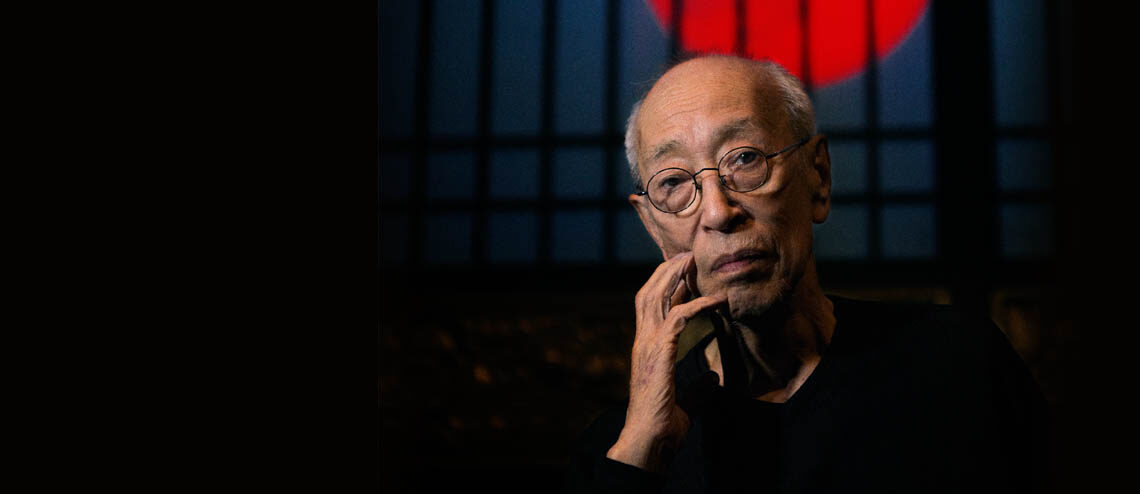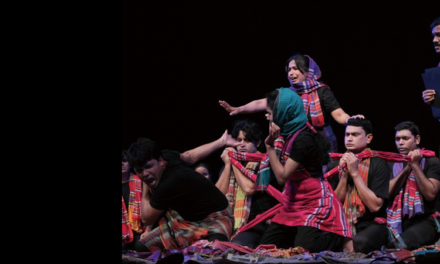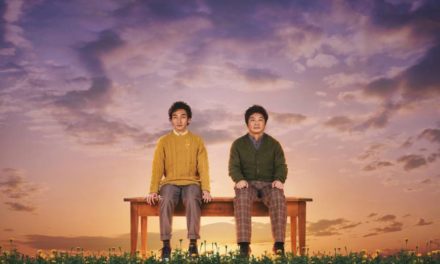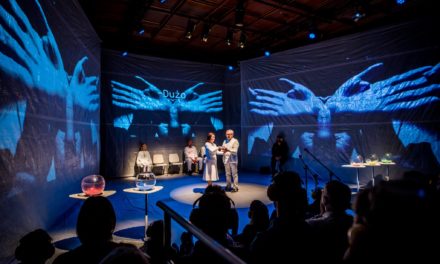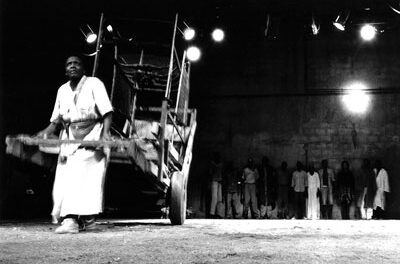Part of the Asian Theatremakers series
I met the late Japanese director Yukio Ninagawa in 2013 when his company returned to perform in Singapore for the first time in more than 20 years. I interviewed him about his production of Musashi, which focused on the rivalry between two swordsmen and the futility of revenge, and we spent about an hour together in a small conference room at Esplanade – Theatres on the Bay.
Ninagawa-san was small, stooped, and perfectly dressed in a well-ironed black jacket over a crisp white shirt.
He became increasingly animated over the course of our interview, bridged by a nervous but enthusiastic translator, and I remember him as being refreshingly blunt, letting slip about directors he disdained (“His work used to be very exciting. But not anymore.”) and eagerly promoting his eighth production of Hamlet, his favorite Shakespeare play, which wasn’t public news at the time.
His producer had to hastily add, post-interview, that any word of this production was strictly off the record.
That final production of Hamlet was staged in 2015, a year before Ninagawa died at the age of 80. The theatre luminary is perhaps best known for his stunning interpretations of the Western theatre canon that have headlined festivals and sold out venues around the world. He fused Shakespearean and Ancient Greek dramas with the formalized conventions of Noh and Kabuki theatre, producing astonishing productions that paid homage to the original texts as much as they clarified and reframed them for a contemporary audience.
Early life and influences
Ninagawa was born in 1935 in Kawaguchi, a small city on the outskirts of Tokyo. The son of a tailor, he initially intended to become a painter, but failed the entrance examination to the Tokyo University of the Arts and became an actor instead. He eventually turned to directing at the age of 30, founding the agitprop group Gendaijin Gekijo (loosely translated as The Theatre of the Modern or The Modern People’s Theatre), and working closely with his contemporary, the Japanese playwright Kunio Shimizu, mounting several of his plays.
Several theatre critics have drawn a connection between Ninagawa’s early artistic ambition and the visual spectacle of his productions. Whether or not his painterly inclinations had anything to do with his pictorial flair on stage is anyone’s guess, but Ninagawa was clear about one particular influence – that of the celebrated theatre director Peter Brook. Brook’s stripped-down “white box” production of A Midsummer Night’s Dream, first staged in 1970 by the Royal Shakespeare Company before embarking on a world tour, was pivotal to Ninagawa’s development as a director.
He told the drama critic and researcher Akihiko Senda, “Brook’s directorial tour de force in his A Midsummer Night’s Dream exercised a decisive influence upon my career as a director. I wondered, with astonishment, if one could put on Shakespeare as freely as this – as freely as our contemporary plays. I felt released to realize I could do anything I liked in staging Shakespeare.”
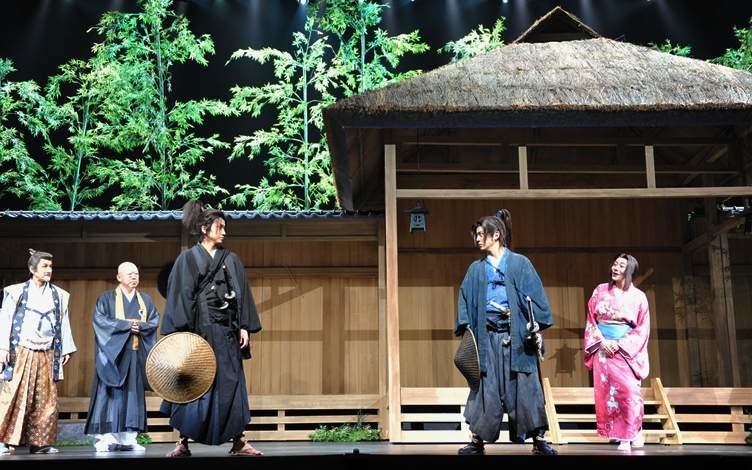
Ninagawa’s Musashi, staged in 2013 at Esplanade.
Japanese iconography and cultural cringe
Ninagawa’s first attempt at Shakespeare was Romeo And Juliet in 1974 when he was invited to work with Tokyo’s Toho Company by producer Tadao Nakane. Ninagawa had not yet struck upon framing Shakespeare within a Japanese context. His Romeo And Juliet was staged with actors in full Renaissance-style costume; his first King Lear, staged a year later, also featured performers in western dress.
It was his third attempt, and his first Hamlet, that marked out the path he would pursue as director, fusing traditions instantly recognizable to his Japanese audience with the bard’s translated but otherwise unaltered text. His 1978 Hamlet featured strong Japanese iconography, particularly the hina dolls often displayed during the country’s annual Festival of Dolls.
These exquisite, intricate dolls are arranged on tiers in a strict hierarchy, with the emperor and empress perched right on the very top, followed by other courtiers and ladies-in-waiting, with attendants and various domestic paraphernalia occupying the bottom tiers. Ninagawa positioned his actors on large tiers on stage, recreating the hina doll structure and alluding to Japan’s aristocracy – giving his Japanese audience a sense of the familiar while acquainting them with old-world Europe and what was “rotten in the state of Denmark” (Hamlet, Act I, Scene IV).
This deliberate appropriation of Shakespeare would continue throughout his body of work. Ninagawa was determined to erase a prevalent Japanese view of Shakespeare as originating from some sort of superior culture. He said in 1998,
There’s one more reason why I transfer foreign plays to Japanese settings, and that is the transparent phoniness of the attempt [by Japanese actors] to mimic the outward form of foreigners. […] Just seeing people wearing tights and blond wigs on stage fills me with a sense of embarrassment, which alone is enough to alienate me from the theatre altogether. To avoid this kind of theatre, I must come up with artistic plans that resolve these various problems. In the case of Macbeth, for example, it is why I set the play within a Buddhist altar (butsudan).”
Watch an interview with Japanese actor Masachika Ichimura about Macbeth and working with Ninagawa.
Macbeth and international acclaim
His Macbeth, set in 16th-century Japan, was the production that would bring him worldwide acclaim following its international debut at the 1985 Edinburgh International Festival. Ninagawa’s work had gained prominence within Japan during a period of social turbulence in the 1960s and 1970s, coinciding with the rise and collapse of the New Left radical political movement, which brought riots, protests, and substantial bloodshed – and his Macbeth responded to the political backdrop against which it was created.
In 1972, members of the United Red Army armed revolutionary group were arrested after a shootout with riot police. They then admitted that they had lynched about a dozen other members of their own group in their remote mountain base during “self-criticism” sessions.
While sympathetic to the politics of the New Left, Ninagawa was shocked and haunted by the horrifying cruelty of these extreme factions, and he later revealed that the dead inside Macbeth’s altar were an echo of the fallen soldiers of the United Red Army.
The specificity of Ninagawa’s references and Japanese framing continued throughout his stagings of Shakespeare.
His take on The Tempest, for instance, was set on the former penal settlement of Sado Island, and subtitled “A Rehearsal of a Noh Play on the Island of Sado”; his version of A Midsummer Night’s Dream featured an iconic stone garden based on Kyoto’s 15th-century Ryoanji Temple.
His popularity in the United Kingdom continued to grow, and he would go on to direct British actors such as Alan Rickman (Tango At The End Of Winter) and Michael Sheen (Peer Gynt) in venues the likes of the Barbican and the National Theatre. Ninagawa was also staging other classics from the western canon, with visually stunning interpretations of Sophocles’ Oedipus Rex (his favorite Greek tragedy), Bertolt Brecht’s Threepenny Opera, Anton Chekhov’s Three Sisters and The Seagull and many more, from the complex family dramas of American playwright Tennessee Williams to the absurd avant-garde of Irish playwright Samuel Beckett.
His production of Euripides’ Medea was staged together with his Macbeth to widespread acclaim at the 1992 Singapore Arts Festival. He often drew from Noh and Kabuki conventions, both subverting and celebrating them. With these productions came lavish plaudits, with critics fawning over his “astonishing visual bravura” (The Guardian) and “moments of pure magic” (The New York Times).
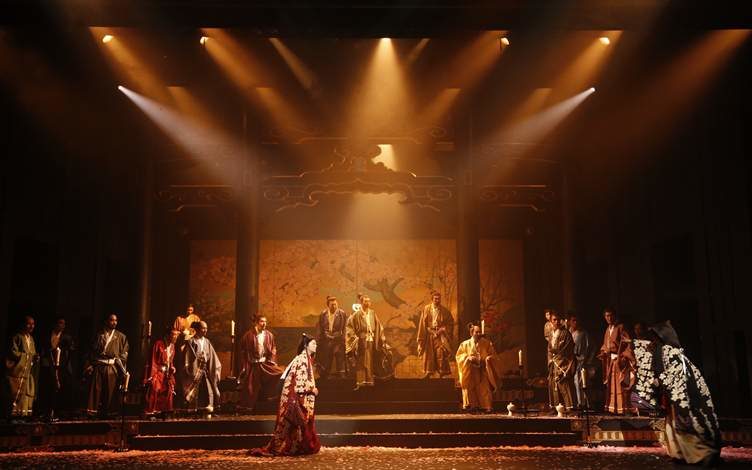
The majestic butsudan in Ninagawa’s Macbeth. Photo by Takahiro Watanabe.
Adapting Japanese texts
While his love of western classics was arguably his cornerstone, Ninagawa also left his inimitable stamp on both classical and contemporary Japanese texts. He often staged work by the late Japanese playwright Hisashi Inoue, whose plays were popular throughout the 20th century. One of these works was Musashi, which travelled to Singapore in 2013 as part of Esplanade’s 3 Titans Of Theatre series that also included Peter Brook and Simon McBurney of the inventive UK theatre company Complicite.
Ninagawa also revelled in adapting the supposedly unadaptable–such as Hi No Tori (Phoenix), the unfinished magnum opus of the late manga legend Osamu Tezuka, and Japanese literary giant Haruki Murakami’s best-selling and labyrinthine novel Kafka On The Shore.
I watched Kafka On The Shore when it came to the Esplanade Theatre in 2015, and it was as faithful to the original text of two intertwining stories as it was imaginative in its interpretation of fantastical journeys through space and time–and even a trio of talking cats.
Ninagawa was inspired by the detailed dioramas of the American Museum of Natural History, and his large set pieces occupied enormous plexiglass boxes that slid soundlessly across the stage. These life-sized dioramas transformed the stage from scene to scene—from a brightly-lit row of vending machines to a lush forest or a silent library—with the help of a team of tireless, black-clad stagehands much like the kuroko one might see in kabuki productions or bunraku puppetry.
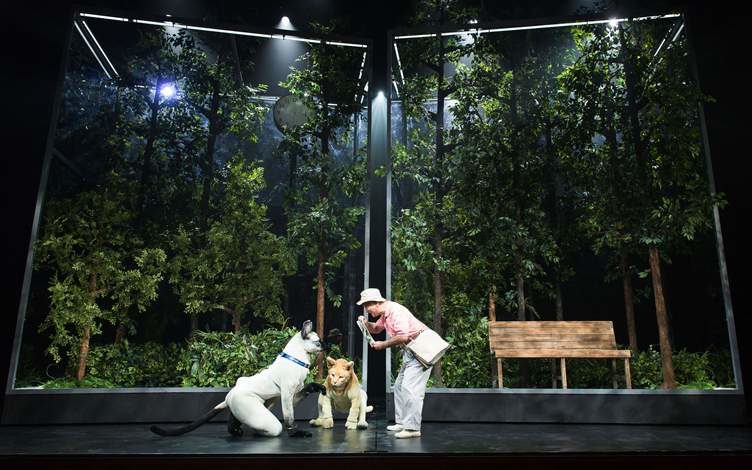
Talking cats in Ninagawa’s Kafka On The Shore, staged in 2015 at Esplanade. Photo by Ung Ruey Loon
“Dialogues with the dead”
I caught Ninagawa’s Macbeth at the Barbican in London prior to the Singapore leg of its international tour. Amidst the applause of the curtain call, the screen doors of the enormous butsudan slid open once again to reveal the entire cast gazing up at a photograph of Ninagawa-san suspended halfway above the stage.
They bowed, then applauded him together with the rest of us. Ninagawa’s inspiration for framing Macbeth within the butsudan had come from his own experience in front of the family altar, offering sticks of incense for prayer and remembering his late father and brother. “At that moment,” he said in a 1993 interview,
the idea crossed my mind that Macbeth could be a story of my ancestors or even myself, if it originated as a fantasy from my dialogues with the dead.
I like to imagine that we were communing with him at the altar he built in the theatre and that our applause was a pleasing offering–just as this Macbeth is a posthumous paean to a beloved director.
This post was written by the author in their personal capacity.The opinions expressed in this article are the author’s own and do not reflect the view of The Theatre Times, their staff or collaborators.
This post was written by Corrie Tan.
The views expressed here belong to the author and do not necessarily reflect our views and opinions.

